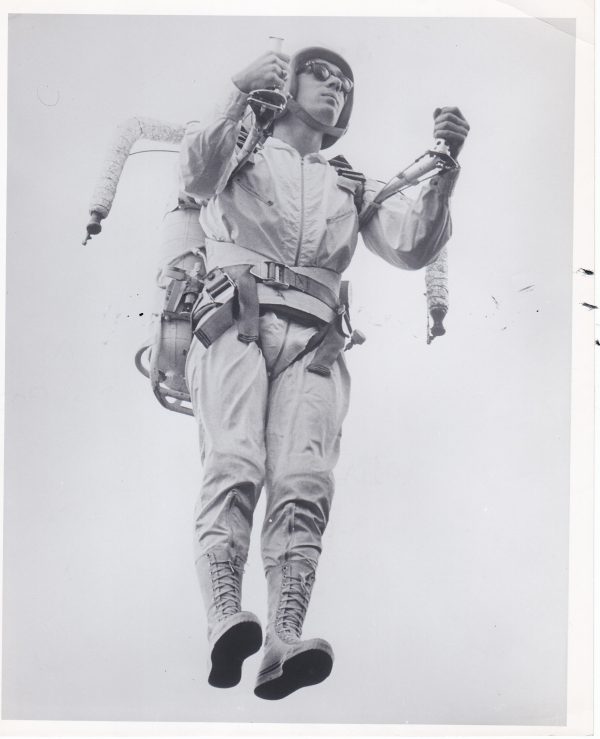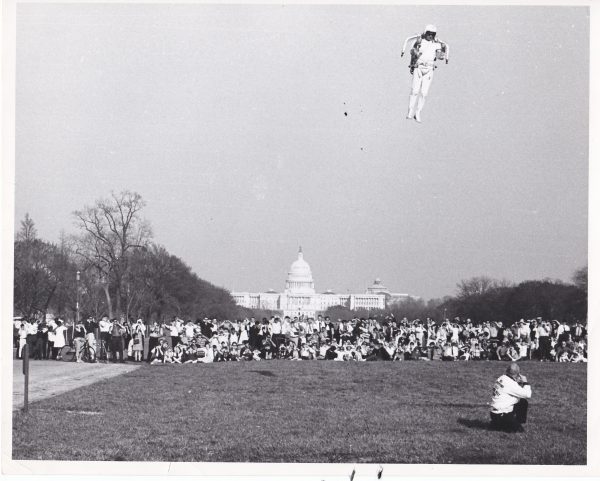In the twentieth century, the jetpack became synonymous with the idea of a ‘futuristic society.’ Appearing in cartoons and magazines, it felt like a matter of time before people could ride a jetpack to work. But jetpacks never became a mainstream technology, leaving many to wonder… why did they fall off the radar?
The Rocket Man
Heading into the Cold War, research into jetpack technology was funded primarily by the American military. “Anything to give you an advantage in war is something your military wants. So people are thinking, hey, if we could strap rockets to soldiers who are running across a field and it made them run faster, they’d be harder to shoot, they’d get farther,” says Steve Lehto, author of the book The Great American Jet Pack. The military reached out to a number of contractors to develop a functioning jetpack, and a company called Bell Aircraft Corporation stepped up to the challenge.
American scientists actually developed a working device in the 1960s called “The Bell rocket belt.” The rocket belt was developed by Wendell Moore, a scientist at the aerospace division of the Bell Aircraft Corporation, using funding from the military. The rocket belt used highly concentrated hydrogen peroxide to gain thrust, creating very hot, very powerful jets of steam to gain liftoff. While the belt was technically not a jetpack – meaning it didn’t use jet engines – it was able to lift a person off the ground for twenty seconds at a time.

Moore was the first test pilot for the rocket belt, running indoor tethered flights until an accident broke his knee cap in 1960. In 1961, a different pilot, Hal Graham, ran the first successful rocket belt test, and later a series of public demonstrations. Graham flew the rocket belt in front of John F. Kennedy at Fort Liberty, where the president is said to have been slack jawed watching a man glide through the air.
The military eventually stopped funding the program because it fell short of expectations. The rocket belt was too heavy, too expensive, and could not travel long distances. But Bell Aerospace continued on, and sent the rocket belt on a tour around the world. There was a lot of excitement around the invention – Wendell Moore even told Popular Science magazine that he believed the belt could be publicly available within two to three years.
The Rocket Belt Goes to Hollywood
Bill Suitor was a rocket belt pilot for Bell, and helped popularize the device. Suitor showed off the belt at fairs across the country, eventually visiting a dozen countries and 42 states. Suitor flew the rocket belt at the first Super Bowl, and was the stunt double for James Bond in the 1965 movie Thunderball, perhaps its most famous moment.
While the film’s producers wanted Suitor to not wear a helmet during filming, he refused, and in the final scene, you can see Suitor and another stunt pilot, Gordy Yeager, flying over a French castle before Connery lands next to an Aston Martin.
The Rocket Belt Gets Grounded
The rocket belt was all over culture – Suitor even became a spokesperson for Keds – but by the late 1960s, it was clear that the device didn’t have a lot of civilian applications. Wendell Moore developed a new version of the rocket belt, using kerosene instead of hydrogen peroxide, but he only saw the device fly once without tethers before dying of a heart attack in 1969. Bell then ended the program and gave away their prototypes to institutions like the Smithsonian.

In subsequent years, hobbyists have kept the dream of the jetpack going, developing new models and flying them at fairs and public demonstrations. Bill Suitor was involved in many tests and public demonstrations, culminating in the 1984 Olympic opening ceremonies in Los Angeles.
 Today, there are still pilots and companies developing jetpacks, some of which have real, literal jet engines. But there is less public interest than 50 years ago. The rocket belt may be a technology of the future that belongs to the past. But you can see one at the Niagara Aerospace Museum in Niagara Falls, and other spots around the country.
Today, there are still pilots and companies developing jetpacks, some of which have real, literal jet engines. But there is less public interest than 50 years ago. The rocket belt may be a technology of the future that belongs to the past. But you can see one at the Niagara Aerospace Museum in Niagara Falls, and other spots around the country.





Leave a Comment
Share